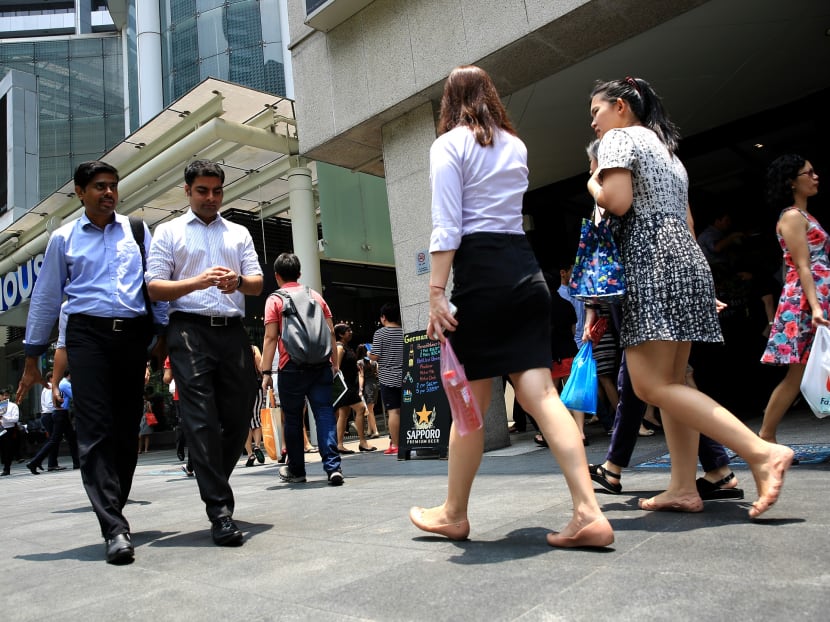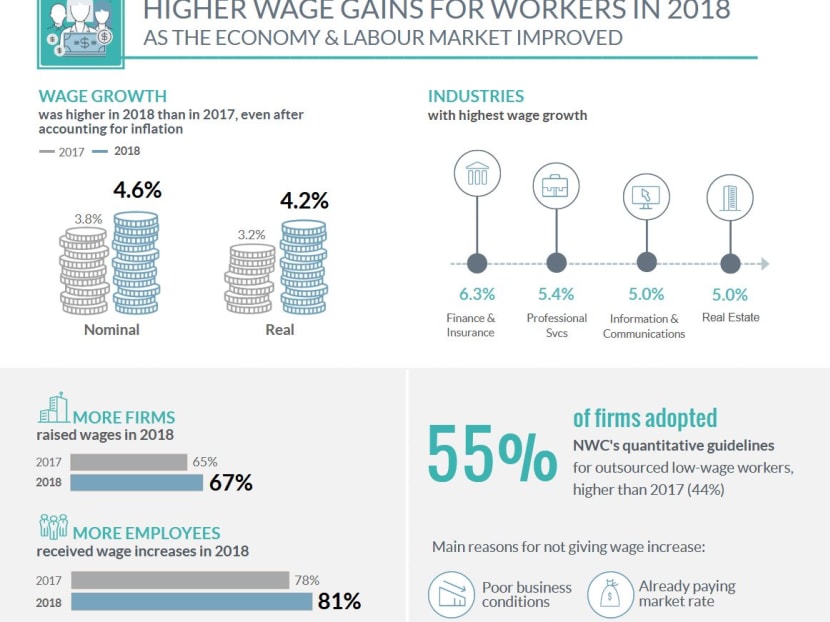More workers here got a wage rise in 2018, but don't expect repeat in 2019, warn economists
SINGAPORE — More employees in Singapore enjoyed a pay rise last year than in 2017, and better still, that increase was bigger, thanks to stronger economic and labour market conditions.

Workers in the financial and insurance services sector took home the biggest pay rise at 6.3 per cent, while pay rises for construction and retail workers were only 2.8 per cent and 3 per cent respectively.
SINGAPORE — More employees in Singapore enjoyed a pay rise last year than in 2017, and better still, that increase was bigger, thanks to stronger economic and labour market conditions.
Workers in the financial and insurance services sector took home the biggest pay rise — 6.3 per cent — while pay rises for construction and retail workers were only 2.8 per cent and 3 per cent respectively
Across the private sector workforce, even when cost of living rises — inflation of 0.4 per cent — are stripped out, employees still notched up a 4.2 per cent increase in real wages on average, markedly better than the 3.2 per cent rise in 2017.
This pace of wage increases had slowed from 5.4 per cent in 2015 to 3.6 per cent in 2016.
The findings were published by the Ministry of Manpower (MOM) in its Report on Wage Practices 2018, which was released on Wednesday (May 29).

In its report, the ministry said that the higher total wage growth stemmed from a higher basic wage increase of 4 per cent, and an increase in bonuses from two months of basic wage in 2017 to 2.06 months in 2018.
WHAT LED TO EMPLOYEES RECEIVING BETTER PAY
The MOM said that 2018 saw:
Singapore’s economy growing by 3.1 per cent
The labour market performing better than in 2017
Strong employment growth
Lower unemployment and retrenchments
In line with the better economic landscape, the MOM said the proportion of profitable establishments rose as well last year.
And that meant the percentage of firms that raised the wages of their employees rose somewhat to 67 per cent in 2018, compared to 65 per cent in 2017.
This was reflected in 81 per cent of employees receiving higher pay in 2018, up from the previous year’s 78 per cent.
And fewer employees received a wage cut last year, down from 10 per cent in 2017 to 8 per cent in 2018.
However, the MOM said the cuts were “deeper” for workers that did take a cut in 2018. These employees saw their wages falling by 4.3 per cent in 2018, compared to a 3.9 per cent drop in 2017.
HOW ABOUT LOW-WAGE WORKERS?
Low-wage workers are classed as those earning up to S$1,300 a month in basic wages, which was raised from the previous S$1,200 in 2017.
About six in 10 companies gave their low-wage employees a pay increment last year, similar to 2017.
Companies that adopted the National Wage Council’s (NWC) recommended wage increases of S$50 to S$70 fell slightly from 48 per cent in 2017 to 45 per cent in 2018.
REASONS COMPANIES CITED FOR NOT INCREASING WORKERS' PAY
Poor business
Already paying market rate
Business/wage costs
Poor employee performance
Constraints under existing contracts with clients
LOW-WAGE WORKERS PERFORMING IN OUTSOURCED JOBS
A total of 71 per cent of their employers gave them wage hikes last year, up from 55 per cent in 2017.
55 per cent adopted the NWC-recommended quantum last year.
TOP 3 INDUSTRIES THAT SAW HIGHEST TOTAL WAGE CHANGE
Financial & Insurance Services — 2017: 4.2 per cent; 2018: 6.3 per cent
Professional Services — 2017: 4.3 per cent ; 2018: 5.4 per cent
Information & Communications — 2017: 3.9 per cent; 2018: 5 per cent
BOTTOM 3 INDUSTRIES THAT SAW LOWEST TOTAL WAGE CHANGE
Food & Beverage Services — 2017: 4.2 per cent; 2018: 3.8 per cent
Retail trade — 2017: 3.6 per cent; 2018: 3.0 per cent
Construction — 2017: 2.0 per cent; 2018: 2.8 per cent
WHO WAS INVOLVED IN THE STUDY
The report was based on a survey conducted from Dec 18 last year to March 19 this year.
It covered some 5,300 private sector firms with at least 10 employees
There were a total of 1.2 million employees surveyed.
This included 584,100 local full-time employees on the Central Provident Fund (CPF) scheme, with at least a year in service. The rest comprised of 428,000 foreign employees and 187,900 local employees working either full-time, with less than a year of service, or part-time.
REACTIONS TO THE REPORT'S FINDINGS
Ms Selena Ling, head of treasury research and strategy at OCBC Bank, said: “The healthy wage picture is positive for the man on the street. Real wage growth in the last two years also likely benefited from subdued headline inflation (of less than 1 per cent year-on-year).”
Mr Irvin Seah, DBS Bank's senior economist, said: “By and large, the wage growth is almost a mirror image of the performance of the various sectors and industries… However, there are some sectors that have underperformed such as the retail and construction sector.”
Mr Seah added that productivity growth in the construction sector is one of the weakest, but it should not come as a surprise that it has the lowest wage growth as well because the majority of the labour force is foreign.
He said the outlook for the retail sector is not positive as the threat from e-commerce is unlikely to be going away anytime soon.
Mr Song Seng Wun, an economist with CIMB Private Banking, said: “Will we see (2018’s good performance) heading in 2019 and 2020 as (US-China) trade tensions intensify? Probably not.” This was a sentiment that all three economists shared.
ON COMPANIES ADOPTING NWC'S GUIDELINES
Mr Mayank Parekh, the Chief Executive Officer of the Institute for Human Resource Professionals, said: “We are making progress with a higher percentage (of companies) adopting (the) guidelines. Coupled with Progressive Wage Model in security, cleaning and landscape sectors, more groups of low-wage workers have benefited in terms of real wage gains in a more sustainable manner.”
National Trades Union Congress' (NTUC) assistant secretary-general Melvin Yong said he is happy that the proportion of establishments that have adopted the guidelines has been “increasing year on year” since 2016.
“This is testament of the efforts by our unions and Singapore National Employers Federation in communicating the guidelines and encouraging companies to adopt it,” he said.
He added that the labour movement should continue to engage companies and to “work closely together” on ways to adopt the NWC guidelines in their companies, taking into consideration the varied circumstances each company faces.
In a Facebook post, NTUC’s second assistant secretary-general Patrick Tay said: “Employers must be encouraged to continue to share relevant information, such as company wage information, business performance and prospects, with unions to ensure wage increases are fair and sustainable.”
He said the labour movement and the unions should continue to monitor their respective sector’s performance closely and “ensure employers reward their employees” with wage increase that matches the firms' performance, productivity gains and employee’s contribution.
He added that this is especially so for the manufacturing sector where “productivity is higher than wage growth over the last five years”.
WHAT SOME COMPANIES ARE SAYING
Benchmark Cleaning Services director Jason Tan said that he has increased the wages of his 28 employees in accordance with the guidelines recommended by the NWC.
But as a result, his customers have to bear the increase in the cost of services. “Most of them understand this as it is not fair for us to absorb the costs,” he said.
Mr Tan added that operating his business is a challenge as the cleaning sector is a “price war” with very low profit margins.
Still, he tries to reward his employees when he can by giving them red packets on special occasions such as Chinese New Year.
Reachfield Security & Safety has also been following the NWC’s guidelines. The security company’s general manager Grace Lim said that it has not been an issue for the firm to adhere to the recommendations for its 1,000 employees.








